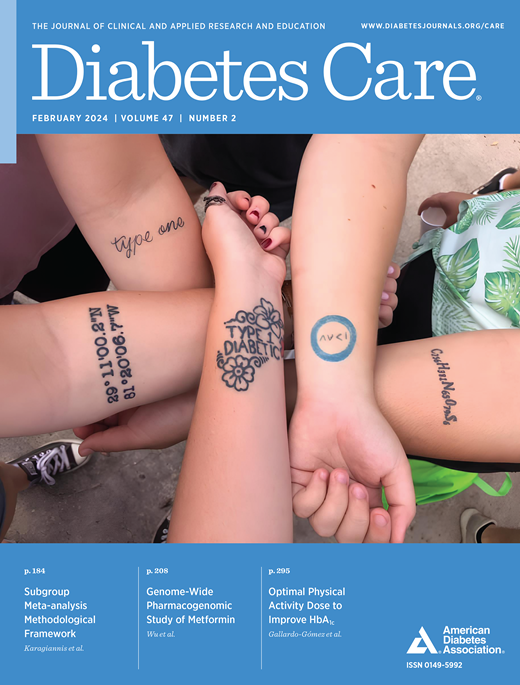Contrasting Adult and Pediatric Populations in a Cohort of At-Risk Relatives in The T1D TrialNet Pathway to Prevention Study
IF 16.6
1区 医学
Q1 ENDOCRINOLOGY & METABOLISM
引用次数: 0
Abstract
OBJECTIVE More than half of incident type 1 diabetes (T1D) occurs in adults, yet research on disease progression predominantly focuses on at-risk children. We compared autoantibody screening outcomes and T1D progression in adults versus children. RESEARCH DESIGN AND METHODS We studied 135,914 children (aged <18 years) and 99,795 adult relatives of individuals with T1D screened in the TrialNet Pathway to Prevention study. In autoantibody positive participants, we compared progression rates, associations with risk factors, and performance of metabolic risk scores. RESULTS Adults were more likely than children to screen positive for a single autoantibody (4.0% vs. 2.6%) but less likely for multiple autoantibodies (0.83% vs. 2.8%; P < 0.001). Progression to stage 3 disease was lower in adults with single autoantibody positivity or stage 1 T1D than in children (5-year risks: single autoantibody, adults 8.2% vs. children 22%, P < 0.001; stage 1, adults 17% vs. children 47%, P < 0.001). However, adults with stage 2 T1D at initial staging oral glucose tolerance test had comparable 5-year progression risks to children (78% for both groups). A higher proportion of adults progressing to clinical diabetes were single autoantibody positive (40% vs. 15%; P < 0.0001); these individuals commonly had single glutamic acid decarboxylase positivity and had lower type 1 but higher type 2 genetic risk scores compared with multiple autoantibody positive adults. HbA1c and established risk indices more effectively identified progressors in adults compared with children. CONCLUSIONS Autoantibody positive adult relatives have distinct autoantibody trajectories and progression risks compared with children, suggesting the need for tailored monitoring and intervention strategies.在T1D试验网络预防途径研究中,高危亲属队列中成人和儿童人群的对比
超过一半的1型糖尿病(T1D)发生在成人中,但疾病进展的研究主要集中在高危儿童身上。我们比较了成人和儿童的自身抗体筛查结果和T1D进展。研究设计和方法我们研究了在TrialNet预防途径研究中筛选的135,914名儿童(18岁)和99,795名T1D患者的成年亲属。在自身抗体阳性的参与者中,我们比较了进展率、与危险因素的关联以及代谢风险评分的表现。结果:成人比儿童更有可能筛查出单一自身抗体阳性(4.0%比2.6%),但筛查出多种自身抗体阳性的可能性较低(0.83%比2.8%;P, lt;0.001)。成人单一自身抗体阳性或1期T1D患者进展至3期疾病的风险低于儿童(5年风险:成人单一自身抗体8.2% vs儿童22%,P <;0.001;第一阶段,成人17%,儿童47%,P <;0.001)。然而,在初始阶段口服糖耐量试验中,成人2期T1D患者的5年进展风险与儿童相当(两组均为78%)。单个自身抗体阳性的成年人发展为临床糖尿病的比例更高(40% vs 15%;P, lt;0.0001);这些个体通常具有单一谷氨酸脱羧酶阳性,与多种自身抗体阳性的成年人相比,具有较低的1型遗传风险评分,但较高的2型遗传风险评分。与儿童相比,HbA1c和已建立的风险指标更有效地识别成人的进展。结论与儿童相比,自身抗体阳性的成年亲属具有不同的自身抗体轨迹和进展风险,提示需要定制监测和干预策略。
本文章由计算机程序翻译,如有差异,请以英文原文为准。
求助全文
约1分钟内获得全文
求助全文
来源期刊

Diabetes Care
医学-内分泌学与代谢
CiteScore
27.80
自引率
4.90%
发文量
449
审稿时长
1 months
期刊介绍:
The journal's overarching mission can be captured by the simple word "Care," reflecting its commitment to enhancing patient well-being. Diabetes Care aims to support better patient care by addressing the comprehensive needs of healthcare professionals dedicated to managing diabetes.
Diabetes Care serves as a valuable resource for healthcare practitioners, aiming to advance knowledge, foster research, and improve diabetes management. The journal publishes original research across various categories, including Clinical Care, Education, Nutrition, Psychosocial Research, Epidemiology, Health Services Research, Emerging Treatments and Technologies, Pathophysiology, Complications, and Cardiovascular and Metabolic Risk. Additionally, Diabetes Care features ADA statements, consensus reports, review articles, letters to the editor, and health/medical news, appealing to a diverse audience of physicians, researchers, psychologists, educators, and other healthcare professionals.
 求助内容:
求助内容: 应助结果提醒方式:
应助结果提醒方式:


